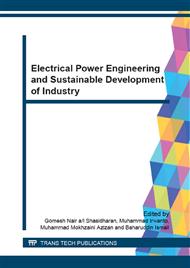[1]
Cooray, V. (2003). Mechanism of the lightning flash. In The lightning flash (pp.127-225). London: Institution of Electrical Engineers.
DOI: 10.1049/pbpo034e_ch4
Google Scholar
[2]
Haddad, M. A., V. A. Rakov, & S. A. Cummer (2012). New measurements of lightning electric fields in Florida: Waveform characteristics, interaction with the ionosphere, and peak current estimates. J. Geophys. Res., 117, D10101.
DOI: 10.1029/2011jd017196
Google Scholar
[3]
C. Gomes, V. Cooray & M. Z. A. Ab. Kadir (2013). Vertical Electric Fields And Field Change Parameters Due To Partly Inclined Lightning Leader Channels. PIER, 135, 55-80.
DOI: 10.2528/pier12081809
Google Scholar
[4]
Nag, A., & Rakov, V. (2014). Parameters of Electric Field Waveforms Produced by Positive Lightning Return Strokes. IEEE Transactions On Electromagnetic Compatibility, 56(4), 932-939.
DOI: 10.1109/temc.2013.2293628
Google Scholar
[5]
Ferro, M., Saba, M., & Pinto, O. (2012). Time-intervals between negative lightning strokes and the creation of new ground terminations. Atmospheric Research, 116, 130-133.
DOI: 10.1016/j.atmosres.2012.03.010
Google Scholar
[6]
Pinto Jr., O., Pinto, I. R. C. A., Saba, M. M. F., Solorzano, N. N., & Guedes, D. (2005). Return stroke peak current observations of negative natural and triggered lightning in Brazil. Atmospheric Research, 76(1-4), 493–502.
DOI: 10.1016/j.atmosres.2004.11.015
Google Scholar
[7]
Schumann, C., Saba, M., da Silva, R., & Schulz, W. (2013). Electric fields changes produced by positives cloud-to-ground lightning flashes. Journal Of Atmospheric And Solar-Terrestrial Physics, 92, 37-42.
DOI: 10.1016/j.jastp.2012.09.008
Google Scholar
[8]
Nag, A., & V. A. Rakov (2012). Positive lightning: An overview, new observations, and inferences. J. Geophys. Res., 117, D08109.
DOI: 10.1029/2012jd017545
Google Scholar
[9]
Brook, M., R. W. Henderson, & R. B. Pyle (1989), Positive lightning strokes to ground, J. Geophys. Res., 94(D11), 13295–13303.
DOI: 10.1029/jd094id11p13295
Google Scholar
[10]
Hojo, J., M. Ishii, T. Kawamura, F. Suzuki, & R. Funayama (1985). The fine structure in the field change produced by positive ground strokes, J. Geophys. Res., 90(D4), 6139–6143.
DOI: 10.1029/jd090id04p06139
Google Scholar
[11]
Rakov, V. (2003). A Review of Positive and Bipolar Lightning Discharges. Bulletin Of The American Meteorological Society, 84(6), 767-776.
DOI: 10.1175/bams-84-6-767
Google Scholar
[12]
Ibrahim, W. I., Ghazali, M. R., Ghani, S. A., & Malek, Z.A. (2011).
Google Scholar
[13]
Heidler, F., & Hopf, C. (1998). Measurement results of the electric fields in cloud-to-ground lightning in nearby Munich, Germany. IEEE Transactions On Electromagnetic Compatibility, 40(4), 436-443.
DOI: 10.1109/15.736204
Google Scholar
[14]
Fleenor, S., Biagi, C., Cummins, K., Krider, E., & Shao, X. (2009). Characteristics of cloud-to-ground lightning in warm-season thunderstorms in the Central Great Plains. Atmospheric Research, 91(2-4), 333-352.
DOI: 10.1016/j.atmosres.2008.08.011
Google Scholar
[15]
Saba, M. M. F., W. Schulz, T. A. Warner, L. Z. S. Campos, C. Schumann, E. P. Krider, K. L. Cummins, and R. E. Orville (2010), High-speed video observations of positive lightning flashes to ground, J. Geophys. Res., 115, D24201.
DOI: 10.1029/2010jd014330
Google Scholar
[16]
Qie, X., Z. Wang, D. Wang, M. Liu, and Y. Xuan (2013), Characteristics of positive cloud-to-ground lightning in Da Hinggan Ling forest region at relatively high latitude, northeastern China, J. Geophys. Res. Atmos., 118, 13, 393–13, 404.
DOI: 10.1002/2013jd020093
Google Scholar
[17]
Mazur, V. (2002). Physical processes during development of lightning flashes. Comptes Rendus Physique, 3(10), 1393-1409.
DOI: 10.1016/s1631-0705(02)01412-3
Google Scholar
[18]
Wu, T., Takayanagi, Y., Funaki, T., Yoshida, S., Ushio, T., & Kawasaki, Z. et al. (2013).
Google Scholar
[19]
Gomes, C., & Cooray, V. (2004). Radiation field pulses associated with the initiation of positive cloud to ground lightning flashes. Journal Of Atmospheric And Solar-Terrestrial Physics, 66(12), 1047-1055.
DOI: 10.1016/j.jastp.2004.03.015
Google Scholar


